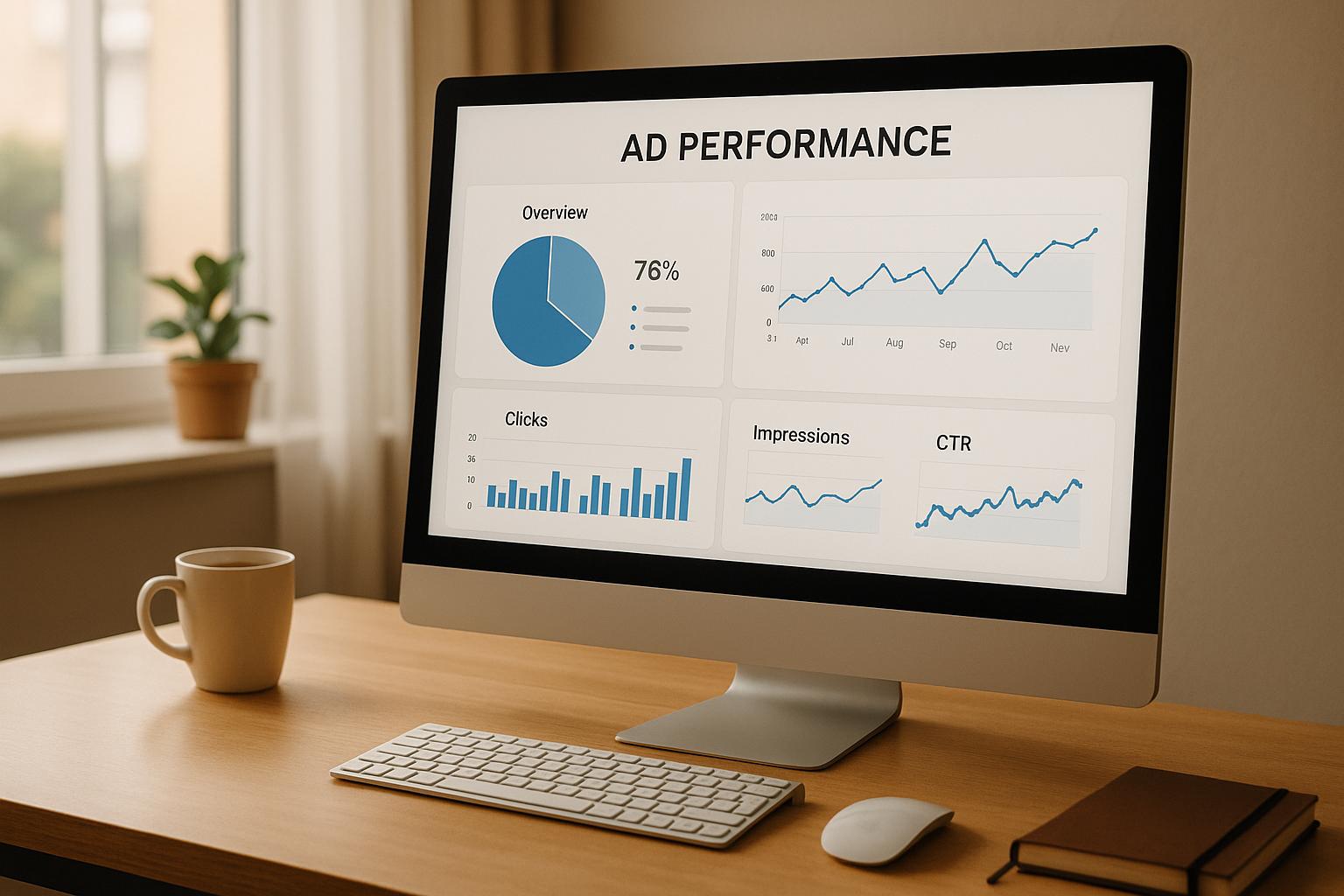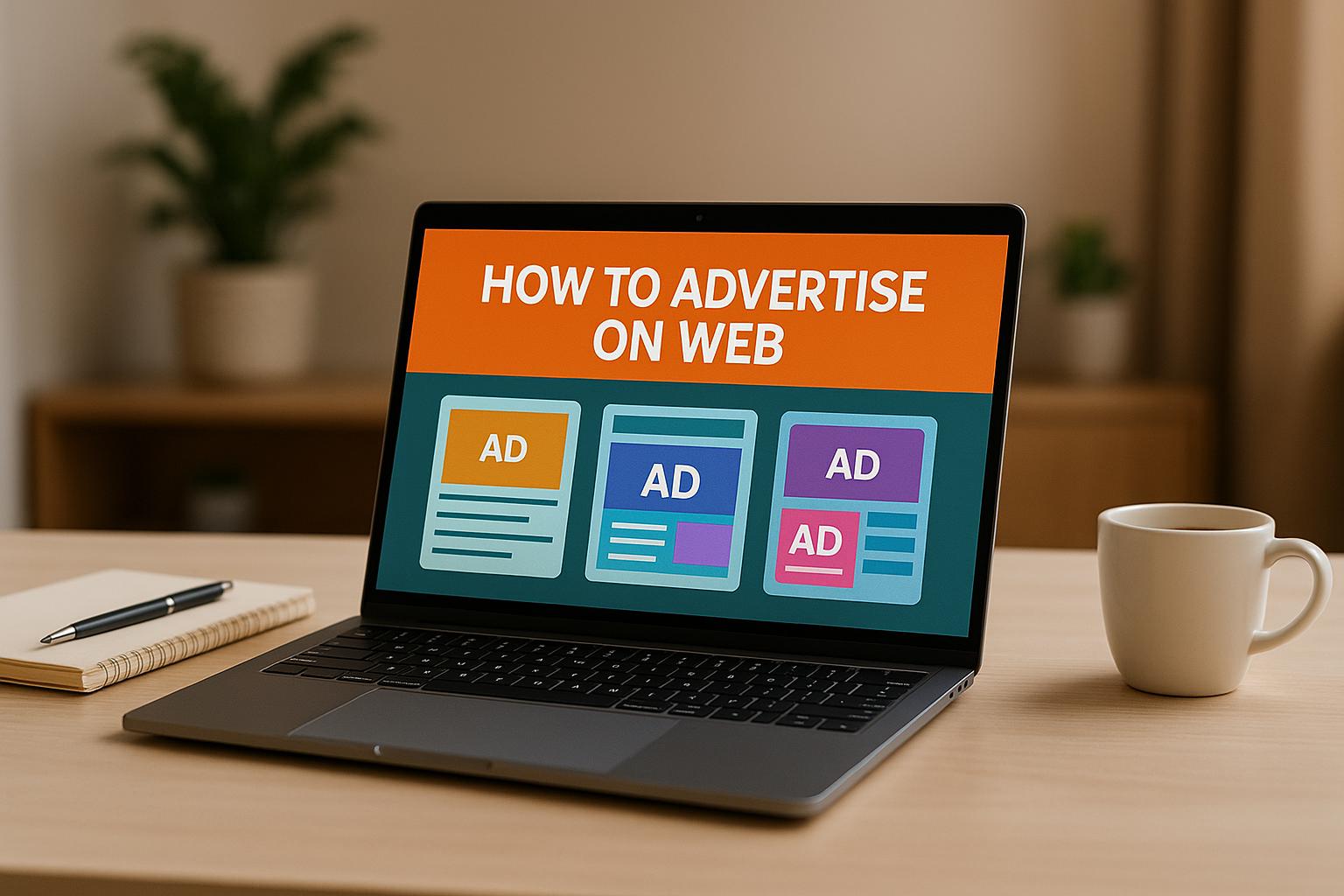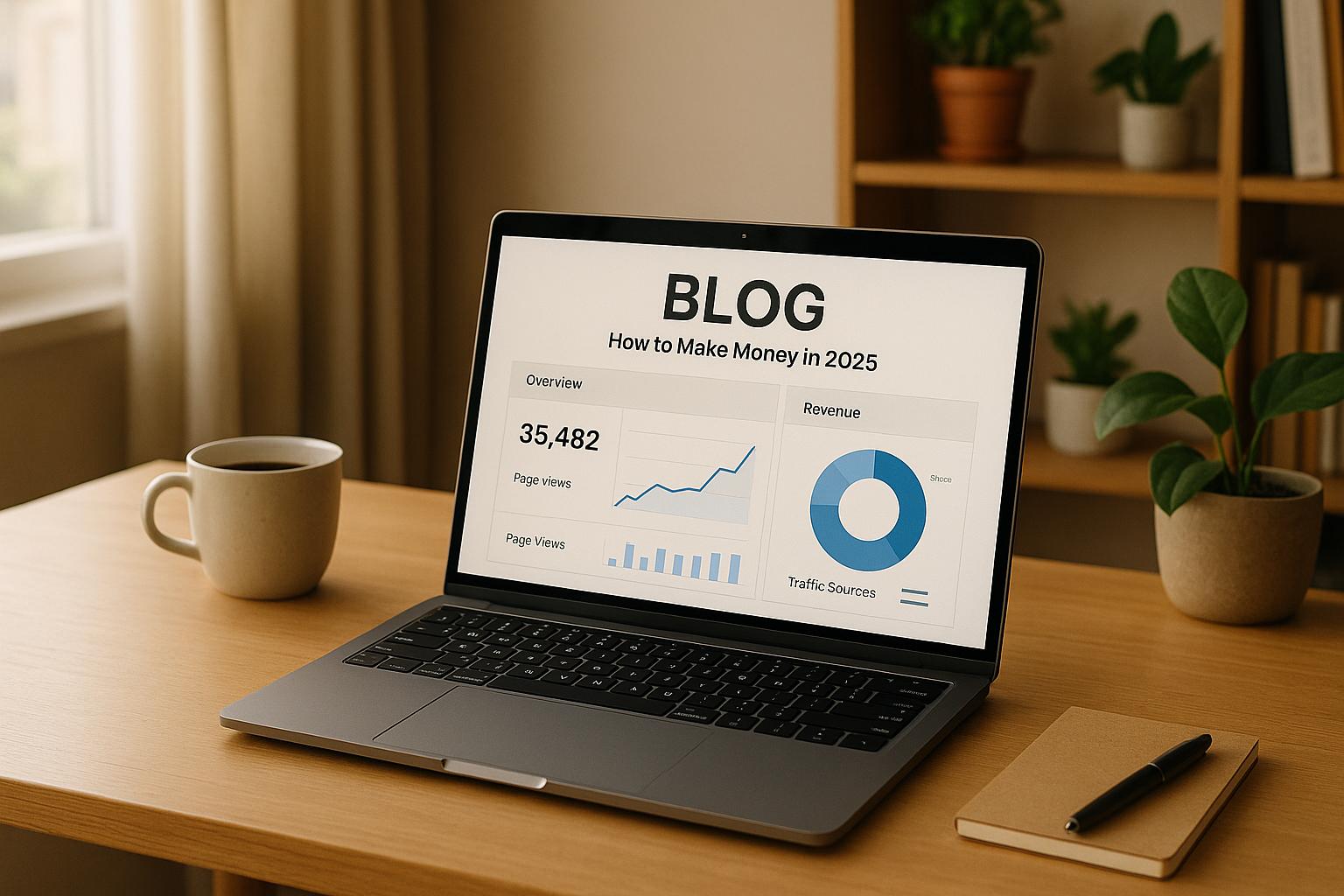Digital publishers are navigating a rapidly evolving ad landscape in 2025. With global ad spending projected to hit $1.3 trillion, here’s what you need to know:
- AI and Search Trends: 79% of users are expected to adopt AI-enhanced search by 2026, while traditional search traffic may shrink by 25%.
- Privacy Challenges: Stricter data privacy regulations and the rise of "zero-click" behavior are pushing publishers to rethink ad strategies.
- First-Party Data Wins: 94% of marketers report higher ROI with targeted ads driven by first-party data.
- Diversification Matters: Successful publishers are leveraging video, newsletters, podcasts, and automation tools to create multiple revenue streams.
Top Ad Platforms for Publishers:
- TinyAdz: Ideal for niche publishers. Focuses on human-only traffic, transparent reporting, and flexible monetization options.
- Google Ad Manager: Best for large publishers. Offers advanced targeting, programmatic advertising, and detailed reporting tools.
- Ezoic: AI-driven platform for optimizing ad placements and layouts. Suitable for mid-sized publishers.
- AdThrive (Raptive): Premium platform for high-traffic lifestyle sites. Prioritizes quality ad placements and offers a 75/25 revenue share model.
- Mediavine: Tailored for niche content creators. Emphasizes site speed, privacy compliance, and targeted ad campaigns.
Quick Comparison
| Platform | Best For | Key Features | Revenue Model | Limitations |
|---|---|---|---|---|
| TinyAdz | Niche publishers | Human-only traffic, no min. traffic | Revenue sharing (varies) | Limited premium features |
| Google Ad Manager | Large publishers | Advanced programmatic tools | Varies | Complex setup |
| Ezoic | Mid-sized publishers | AI-driven optimization, 304% boost | Free or Premium plans | May slow site performance |
| AdThrive | Lifestyle niches | Premium ads, 75/25 revenue share | Revenue sharing (varies) | Requires high traffic |
| Mediavine | Food, parenting, travel | Full-service, privacy-focused | Revenue sharing (varies) | Limited ad placement control |
Publishers must adapt to changing consumer habits, prioritize first-party data, and diversify revenue streams to thrive in 2025’s competitive landscape. Consistent optimization and audience-focused strategies are the keys to sustainable growth.
How Most Digital Publishers Make Money
1. TinyAdz

TinyAdz is a platform tailored for niche publishers looking to earn from their content without compromising their brand's identity. Unlike many traditional ad networks that often display ads disconnected from the audience's interests, TinyAdz matches publishers with advertisers whose products or services genuinely align with their target audience. This approach has drawn in SaaS creators, newsletter writers, bloggers, and directory managers who prioritize quality. By focusing on human-only traffic and offering transparent performance data, TinyAdz provides publishers with the tools and confidence to explore a variety of monetization opportunities.
Ad Monetization Features
TinyAdz goes beyond standard banner ads by offering a range of monetization options. Publishers can turn their directories into revenue-generating assets through directory monetization. The platform also enables all-site traffic solutions, making it possible to earn from every section of a website. Additionally, TinyAdz supports social media monetization, newsletter-based revenue streams, and even event monetization, giving publishers multiple ways to grow their income as their online presence expands.
Audience Targeting Capabilities
With a combination of advanced analytics and strategic ad placement tools, TinyAdz helps publishers deliver ads that truly connect with their audience. Its focus on verified, human traffic ensures that ad placements reach real, engaged users, maximizing the impact of every campaign.
Transparency and Reporting Tools
One of TinyAdz's strengths is its commitment to clear and honest reporting. Publishers can access detailed performance data that emphasizes authentic, bot-free traffic.
Revenue Optimization Strategies
TinyAdz provides publishers with flexible ad formats, allowing them to select campaigns that fit their unique needs. By steering clear of spammy links and irrelevant ads, the platform protects the publisher's brand reputation. Plus, with no minimum traffic requirement, TinyAdz is accessible to smaller publishers while also offering scalability for those with growing audiences.
2. Google Ad Manager
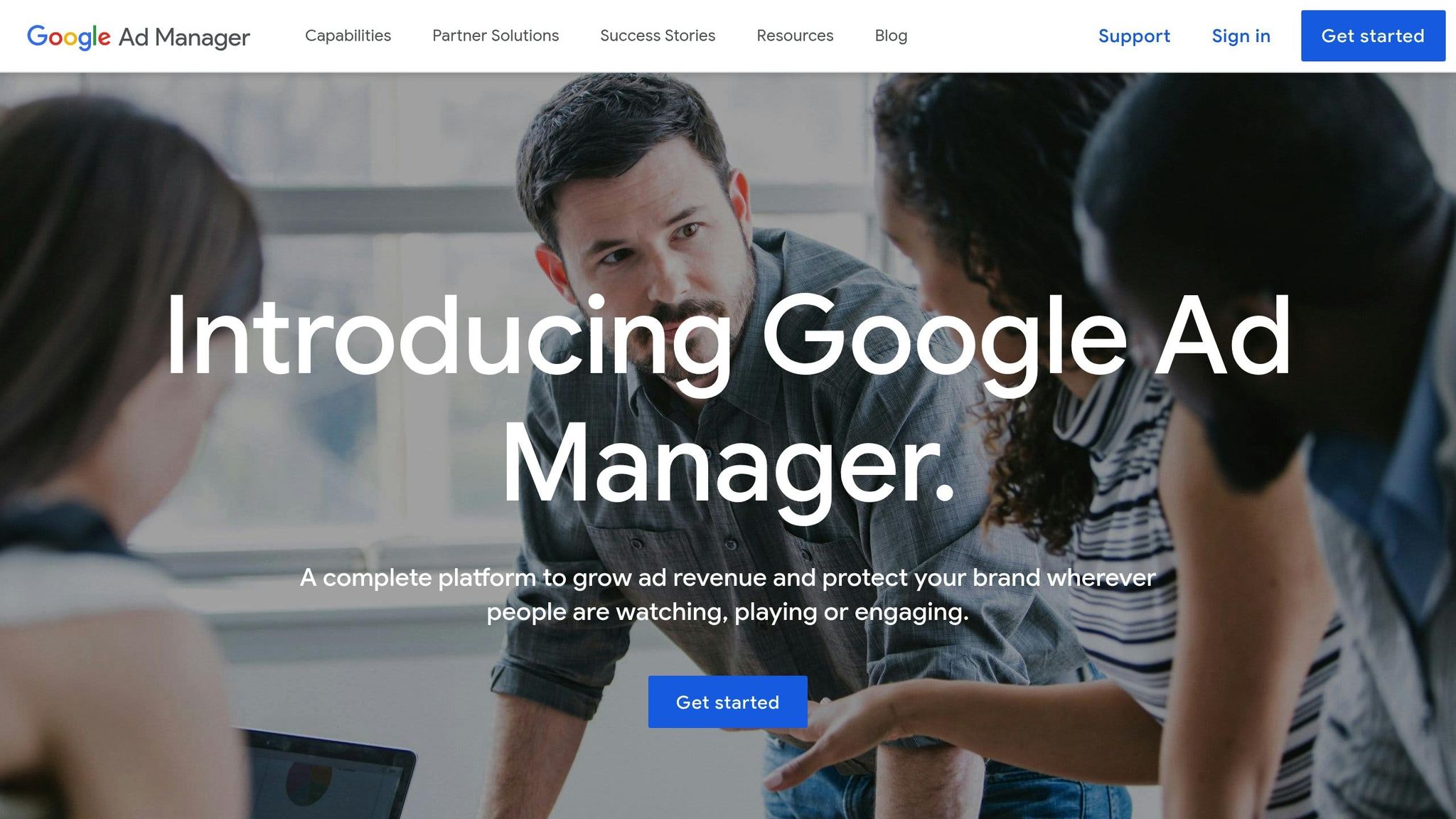
Google Ad Manager is a go-to platform for publishers who need precise control over their advertising operations. With 81% of small publishers using it to monetize their ad inventories, it's become a cornerstone for managing complex ad campaigns. By merging DoubleClick for Publishers and Ad Exchange into one system, it streamlines the ad management process.
Unlike platforms like TinyAdz that cater to niche audiences, Google Ad Manager offers a broader, automated solution for a variety of digital properties.
Ad Monetization Features
Google Ad Manager supports revenue generation across multiple platforms, including websites, mobile apps, connected TVs, and video content. It accommodates various ad formats such as banner, native, in-stream, interstitial, rewarded video, and app open ads.
The platform simplifies revenue management by handling both direct deals and programmatic advertising. Publishers can set price floors based on factors like user location, ad unit, and device, ensuring they don't sell inventory below their preferred rates. Key optimization tools include unified first-price auctions, dynamic allocation, and optimized competition, all designed to maximize revenue from every impression.
Jonathan Bellack, Google's director of product management, highlights the platform’s evolution:
"Automation continues to change the way we do business, with advertisers looking to transact all their campaigns, guaranteed or not, programmatically. That's why we broke away from the traditional constraints of ad servers and SSPs to build new programmatic solutions directly into the product we now call Ad Manager - from our programmatic deals framework to features like Optimized Competition that help you maximize yield across reservations, private marketplaces, and the open auction."
Audience Targeting Capabilities
Google Ad Manager excels in delivering relevant ads through its targeting tools. The free version allows targeting by geography, device, app, and browser, while the premium GAM 360 offers custom audience segmentation. Publishers can create first-party segments based on user interactions, leading to impressive results - one news site boosted direct campaigns by 115% and increased eCPMs by 54%.
Third-party audience segments are also supported, helping publishers reach broader ad categories. By defining key-values and incorporating them into ad tags, publishers can improve ad relevance and boost click-through rates.
Transparency and Reporting Tools
Google Ad Manager provides detailed reporting tools to help publishers track and analyze ad performance. Custom reports can be generated weekly, monthly, or quarterly, using various metrics. Starting in early 2026, the platform will roll out Interactive reports, allowing publishers to create and view results directly within the system. Reports can be exported in formats like Excel and CSV for easy sharing.
To address concerns about transparency in digital advertising, Google introduced the Confirming Gross Revenue feature. This tool allows publishers to verify aggregate gross revenue from specific buyers, ensuring no hidden fees are deducted. Eric Hochberger, CEO of Mediavine, praised the initiative:
"Transparency and trust go hand in hand and giving us additional access and insight into media costs is a step in the right direction. We look forward to being early adopters of the solution and partnering with Google to provide feedback on how to make improvements."
Revenue Optimization Strategies
Google Ad Manager includes tools designed to help publishers maximize their ad revenue. The Opportunities and Experiments feature lets publishers test different configurations to identify potential improvements. Forecasting reports and delivery tools are also available for troubleshooting and optimizing revenue.
The platform offers two versions tailored to different needs:
| Feature | GAM (Free) | GAM 360 (Paid) |
|---|---|---|
| Monthly Impressions | Up to 90 million | Starting at 90 million (negotiable) |
| Key Features | Line item management, historical data, customized reporting, API access | All GAM features plus advanced targeting and direct Google support |
| Open Bidding | No | Yes |
| Multiple Currencies | No | Yes |
To ensure optimal performance, publishers should regularly review delivery settings and leverage forecasting tools. However, over-targeting should be avoided, as it can limit inventory and reduce revenue potential. By combining Google Ad Manager’s advanced features with thoughtful campaign strategies, publishers can create a profitable advertising ecosystem that serves both their audiences and advertisers effectively.
The next table provides a side-by-side comparison of these features across platforms.
3. Ezoic
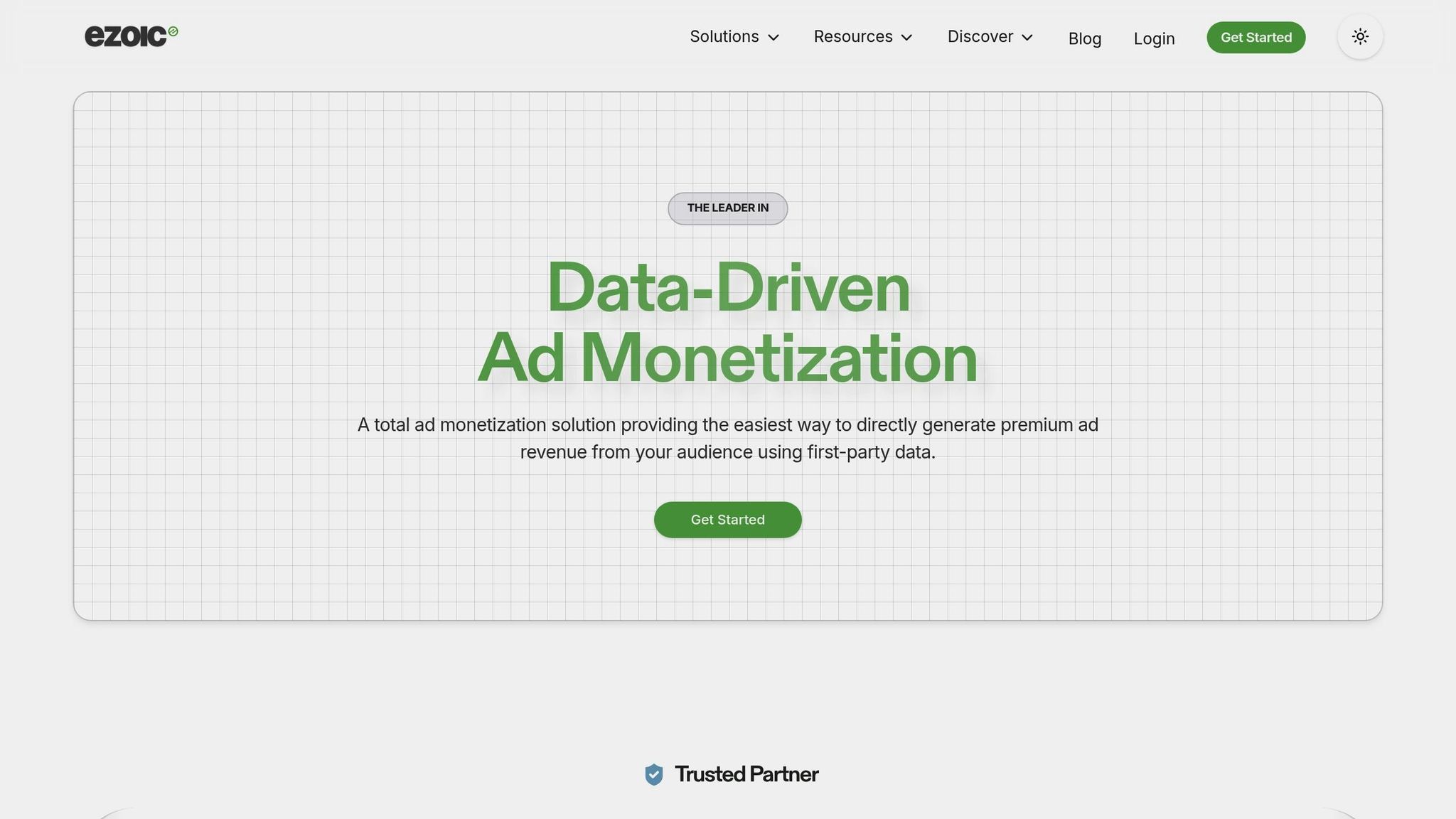
Ezoic takes the concept of advanced targeting and automation, as seen with Google Ad Manager, and pushes it further with its AI-driven testing approach. Unlike traditional ad management systems, Ezoic continuously tests and tweaks layouts, ad placements, and content combinations to strike the perfect balance between user experience and ad revenue. This dynamic system has delivered measurable results for publishers across a variety of industries.
Ad Monetization Features
Ezoic's standout feature is its AI-powered automated testing, which adjusts ad placements, sizes, and formats in real time to boost revenue. Publishers can also connect their existing ad networks through Ezoic's Mediation app, creating a competitive bidding environment among networks. The platform supports a variety of ad formats, including traditional display ads, video content via its Humix tool, and sticky ads that stay visible as users scroll.
One success story comes from ChromeUnboxed.com. After adopting Ezoic, the site experienced substantial growth. Joe Humphrey, one of the founders, shared:
"We generate a substantial portion of our revenue from website ads, which means we need the best tools, support and expertise possible. We have that in Ezoic."
The site reported a 152% increase in revenue, demonstrating how Ezoic can significantly enhance monetization for content-driven websites.
Audience Targeting Capabilities
Ezoic’s AI doesn’t just rely on basic demographics - it digs deeper to create personalized advertising experiences. By analyzing audience data, it tailors strategies to specific visitor segments. This detailed approach helps brands connect with niche audiences while still scaling their campaigns effectively.
A key tool in this process is Ezoic’s ezID technology, which enhances audience identification. Publishers using ezID see a clear advantage, with identified visitors generating 41% higher earnings compared to 13% for non-identified visitors. This underlines the growing importance of first-party data in today’s advertising landscape.
BroadwayWorld has also benefited from Ezoic’s data-driven targeting. Robert Diamond, the company’s CEO and founder, noted:
"With Ezoic, we have a partner that actually helped us take a more data-driven approach with our efforts. The platform has helped leverage our data to improve experiences and increase user value."
In just 30 days, the theater-focused publication saw a 30% jump in revenue per session (ePMV) and a 25% boost in user engagement. These insights feed into Ezoic’s broader analytics capabilities, as outlined below.
Transparency and Reporting Tools
Ezoic equips publishers with detailed analytics through its Big Data Analytics tool, offering real-time insights into how website performance affects earnings. These tools allow publishers to dive deep into revenue data, identifying profitable content areas and optimization opportunities. Custom reports can be created with multiple filters, enabling detailed analysis of metrics like visits, pageviews, and bounce rates. Additionally, page-level performance metrics help evaluate the ROI of specific campaigns, while device-specific reporting highlights differences in earnings between desktop and mobile users, especially on AMP pages.
Revenue Optimization Strategies
Ezoic’s strategy revolves around constant testing and refinement. Publishers are encouraged to experiment with new ad placements - like ads above the fold - to improve visibility. Other key tactics include enabling sticky ads for consistent exposure, linking active AdSense accounts to encourage competitive bidding, and utilizing video tools to unlock additional revenue streams. For those invited, Ezoic Premium provides access to higher-paying ad inventory.
The platform also offers an Access Now program for smaller sites with fewer than 10,000 monthly pageviews, making advanced ad technology accessible to a broader range of publishers. For newsletter publishers, Ezoic has reported an average revenue increase of 9% and a 5% improvement in visitor engagement, proving its ability to enhance various aspects of digital publishing.
sbb-itb-957fd63
4. AdThrive

AdThrive, now known as Raptive, is a premium advertising platform tailored for high-quality, niche content creators. Unlike platforms that cast a wide net, AdThrive is highly selective, accepting only 15-20% of applicants. This exclusivity creates a premium network that benefits both publishers and advertisers by delivering higher-quality ad placements and better revenue results.
The platform works with nearly 3,000 publishers across 60 countries, specializing in lifestyle-focused niches like food, home, parenting, and DIY. This targeted approach strengthens relationships with advertisers who want to connect with these specific, engaged audiences.
Ad Monetization Features
AdThrive emphasizes quality over quantity in its monetization strategy, leveraging two proprietary systems to maximize revenue while maintaining a positive user experience. Their Nucleus system identifies and fills the most lucrative ad spaces on a page, while Marmalade ensures contextual targeting by matching ads to relevant content.
The platform supports a variety of ad formats, including interstitial, mobile, native, and video ads, all managed through header bidding for competitive auctions. To prevent ad overload, AdThrive enforces a strict 30% ad density policy, ensuring ads occupy no more than 30% of a page's content.
Publishers keep 75% of the total ad revenue under AdThrive's 75/25 revenue-sharing model. The platform boasts an average RPM of $13 to $15, which is notably higher than many competitors. Additionally, AdThrive guarantees publishers a 20% revenue increase and promises to raise RPMs by $20 on average when switching from other platforms.
For example, Fatstacksblog.com reported impressive results after adopting AdThrive ads in January 2020. By November of that year, the site’s monthly revenue reached $14,853.49 (desktop), $6,347.90 (mobile), and $729.77 (tablet). Another publisher with 5-6 million monthly page views saw their daily ad earnings jump from $1,300 to $2,300 after making the switch.
Audience Targeting Capabilities
AdThrive’s focus on lifestyle niches allows for precise audience targeting. Using the Marmalade system, the platform analyzes content to pair ads with reader interests. This contextual approach is especially effective for lifestyle content, where readers are often open to discovering relevant products and services.
Advertisers value the platform’s selective publisher network, which inherently offers higher-quality ad placements. As an AdThrive representative explains:
"Advertisers know and trust the quality of sites they find in the AdThrive community, so we work hard to maintain the standards that keep earnings as high as possible for every AdThrive publisher!"
This trust results in stronger advertiser demand and better rates for publishers, as brands are willing to pay a premium to reach AdThrive’s engaged audiences in niches like food, home, and parenting.
Transparency and Reporting Tools
AdThrive offers a robust reporting dashboard through the Raptive platform, allowing publishers to view and analyze ad revenue by ad type, page, device, and traffic source. These detailed insights help publishers identify top-performing content and refine their strategies.
The platform’s reporting tools go beyond basic metrics, enabling publishers to track performance across different ad formats and placements. This level of detail empowers publishers to make informed, data-driven decisions about their content and site optimization.
Revenue Optimization Strategies
AdThrive combines automated tools with human expertise to optimize revenue. One standout feature is its customizable A/B testing, which allows publishers to test both ads and site design for the best performance without compromising user experience.
In addition to ad optimization, AdThrive offers SEO support to help publishers improve their content, driving more traffic and, ultimately, higher ad revenue. The platform also monitors site performance to enhance ad delivery and boost search engine visibility.
To qualify for AdThrive, publishers must meet specific requirements: a Google Analytics account, at least 100,000 monthly pageviews, predominantly U.S.-based traffic, original content, and HTTPS security. AdThrive also recommends tools like Nitropack to improve page speed, as site performance directly impacts ad effectiveness.
Beyond programmatic ads, AdThrive provides opportunities for direct sales and branded sponsorships, offering additional revenue streams while maintaining a quality user experience.
Next, we’ll dive into how Mediavine builds on these monetization strategies to deliver even more value for publishers.
5. Mediavine
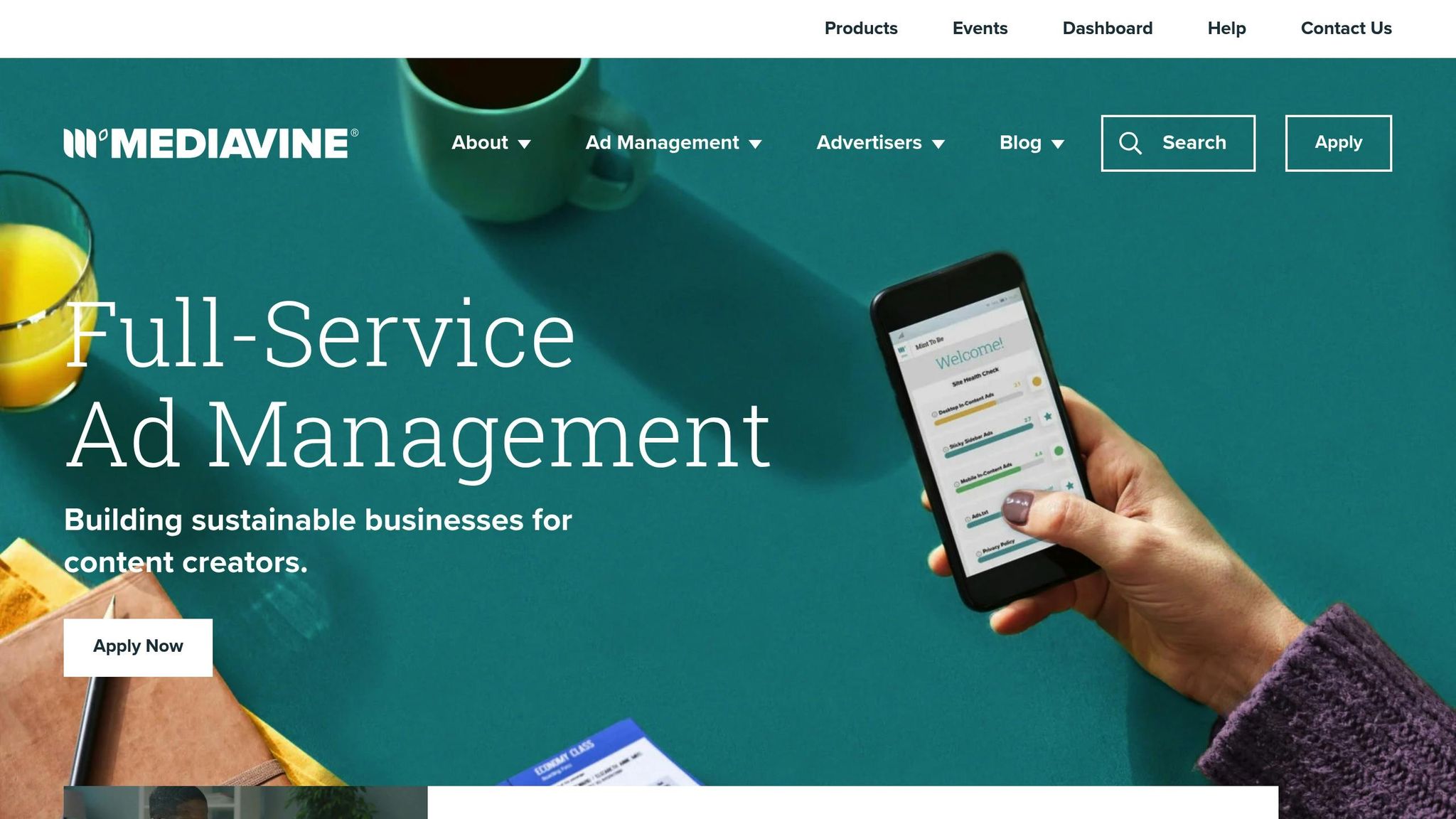
Mediavine stands out as a full-service ad management platform, simplifying the complexities of monetization so publishers can focus on producing high-quality content. With a network of over 10,000 brand-safe sites, Mediavine delivers more than 20 billion ad impressions each month and reaches an audience of over 125 million unique visitors monthly, ranking it as a Top 20 Comscore property.
What sets Mediavine apart is its specialization in niche verticals like Food, Parenting, Travel, and Home. This targeted focus, combined with an audience that is more than 70% female, allows Mediavine to provide advertisers with highly specific and effective solutions.
Ad Monetization Features
Mediavine leverages advanced technology to optimize both performance and revenue. Features like lazy loading and dynamic ad placement ensure ads meet industry standards while maintaining a positive user experience. The platform recently reduced in-content ad density by 54%, proving that less can indeed be more when it comes to balancing user satisfaction and revenue generation.
Among its standout tools is a video player designed to monetize content efficiently. Mediavine also collaborates exclusively with premium ad partners and offers optional plugins that prioritize site speed and SEO - ensuring publishers can generate income without sacrificing user experience.
Audience Targeting Capabilities
Mediavine’s targeting tools go beyond standard demographics, offering MRC-accredited Keyword Targeting and Custom DEI-Owned Site Lists. These features equip advertisers with precise options to connect with their ideal audiences. The platform supports category-based, seasonal, and cookie-less targeting, adapting to the evolving privacy landscape. Impressively, Mediavine represents over 77% of DEI-owned websites, the largest share in the industry.
Through its Uplift by Mediavine program, advertisers can directly invest in diverse-owned sites, creating new revenue streams for underrepresented publishers. This approach not only diversifies ad spend but also enables scalable marketing strategies tailored to every stage of the funnel, driving both awareness and engagement.
Transparency and Reporting Tools
Mediavine provides publishers with a customizable dashboard that offers real-time insights into performance metrics and site health. Key features include tracking top-performing ad units, monitoring privacy compliance, and viewing detailed breakdowns by partner, device, and ad type. Publishers can also analyze earnings against sessions and identify high-performing pages and videos.
In mid-2025, Mediavine transitioned all publishers to a custom Consent Management Platform (CMP) in partnership with CONSENTMANAGER. This move enhanced compliance capabilities and opened doors to increased ad spending in international markets.
Revenue Optimization Strategies
Mediavine’s revenue optimization strategies prioritize reader engagement while maximizing ad performance. CEO Eric Hochberger highlights the company’s commitment:
"Mediavine remains committed to transparency and privacy – but also to making sure our 9,000-plus publishers can build sustainable businesses."
The platform supports publishers with NET 65 payments and proactive measures during revenue dips, ensuring financial stability. Its Brand Safety Policy guarantees that ads and content are placed in appropriate environments, maintaining trust and credibility.
Next, let’s explore how Mediavine compares to other platforms across key metrics and features.
Platform Comparison Table
Choosing the right ad management platform can make a huge difference in maximizing revenue and simplifying operations. Below is a detailed comparison of five popular platforms to help you decide which one aligns best with your goals.
| Platform | Best For | Key Strengths | Revenue Model | Payment Terms | Limitations |
|---|---|---|---|---|---|
| TinyAdz | Niche publishers and small to medium sites | Hyper-targeted ad solutions, no minimum traffic requirements, personalized matchmaking | Revenue sharing (percentage not specified) | Not specified | Limited details on premium features |
| Google Ad Manager | Large publishers with high traffic | Extensive reach, advanced programmatic capabilities, free basic version | Revenue sharing varies | Not specified | Complex setup; suited for enterprise-level users |
| Ezoic | Publishers seeking AI optimization | AI-driven ad placement, reported 304% revenue boost, easy AdSense alternative | Free plan: 10% revenue share; Premium: $49.99/year or $5.99/month | Net 30/60/90 with $20 minimum | May slow site performance; excessive ad placement |
| AdThrive | High-traffic lifestyle sites | Premium brand partnerships, strong performance optimization | Revenue sharing (percentage varies) | Not specified | Requires high traffic (typically 100K+ monthly pageviews) |
| Mediavine | Content creators in food, parenting, travel, and home niches | Full-service management, access to over 125 million monthly visitors | Revenue sharing (percentage varies) | Not specified | Limited control over ad placement |
Each platform offers unique advantages, making it essential to match your needs with the right features. For instance, TinyAdz is ideal for newer or smaller sites, as it doesn't require a minimum traffic threshold. On the other hand, Google Ad Manager caters to large-scale publishers with its advanced programmatic tools, although it can be challenging to set up.
Ezoic strikes a balance for mid-sized publishers, offering AI-driven ad placement that reportedly boosts revenue by 304%. However, its optimization methods can sometimes slow down site performance or result in too many ads on a page. Meanwhile, AdThrive and Mediavine shine in maintaining site speed and providing premium ad opportunities. Mediavine, in particular, focuses on niches like food and parenting, delivering highly targeted campaigns.
When it comes to control, platforms vary significantly. Ezoic gives publishers full control over their ad monetization strategy, while Mediavine takes a more managed approach, offering tools and guidance but less hands-on control. These differences mean your choice should depend on your site's traffic, your expertise, and how involved you want to be in managing ads.
With programmatic advertising expected to account for 91% of digital ad spend in the U.S. by 2025, and 49% of publishers reporting that ad revenue makes up more than half of their income, selecting the right platform is more important than ever for long-term growth.
Conclusion
The digital advertising world is constantly changing, and publishers need a monetization strategy that fits their specific goals and audience. Christine Bode from Bodacious Copy puts it best:
"In the fast-paced world of publishing, staying informed about industry changes isn't just an advantage - it's a necessity".
This highlights why a customized approach to ad monetization is so important.
At the core of any successful strategy is a deep understanding of your audience. Whether you're running a small niche blog or a bustling lifestyle site, your chosen platform and strategy should align with your content and objectives. Knowing your audience is the key to creating a plan that works.
To ensure lasting success, publishers should consistently refine their strategies. This means keeping an eye on performance metrics, experimenting with ad placements, and staying responsive to shifts in consumer behavior. Monetization isn't a one-time setup - it requires constant attention and adjustments to stay effective.
Finally, diversification is essential. Pairing the right platform with thoughtful ad placement, audience insights, and a commitment to ongoing learning can help digital publishers boost revenue while maintaining a user-friendly experience.
FAQs
How can digital publishers use first-party data to boost ad revenue?
Digital publishers can boost their ad revenue by using first-party data to deliver ads that feel more tailored and relevant to their audiences. This approach not only grabs users' attention but also makes ad campaigns more impactful. With the help of first-party IDs, publishers can fine-tune their targeting to reach specific audience groups, improve where ads appear, and track performance with sharper accuracy.
On top of that, first-party data strengthens relationships with advertisers by providing detailed audience insights. Advertisers value this level of precision, which can drive up demand for ad space and open doors to better revenue opportunities. However, to ensure lasting success, publishers must stay transparent about data collection practices and prioritize maintaining user trust.
What are the main advantages of using AI-driven platforms for optimizing ad placements?
AI-driven platforms use artificial intelligence to sift through massive datasets in real-time, making ad placements more effective and improving both user satisfaction and revenue. These systems adjust ad placements dynamically based on how visitors interact with your site, creating a more tailored experience for your audience.
On top of that, AI tools take over time-consuming tasks like ad testing and performance analysis. This automation not only reduces your workload but also boosts your site's performance, increases earnings, and fine-tunes the experience for your specific audience.
How are stricter data privacy laws shaping digital publishers' ad strategies in 2025?
In 2025, new data privacy laws are reshaping how digital publishers approach advertising. The focus has shifted to privacy-first ad strategies that emphasize transparency and earning user trust. Publishers are now required to get explicit user consent, collect only the most necessary data, and rely on anonymized or aggregated information to keep ad targeting effective.
These regulations are pushing publishers to prioritize first-party data and contextual advertising instead of third-party cookies. This shift not only strengthens direct relationships with audiences but also opens doors for building trust and exploring more sustainable ways to grow revenue, even if it means rethinking traditional strategies.
